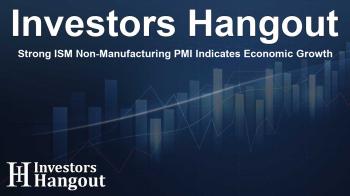Strong ISM Non-Manufacturing PMI Indicates Economic Growth

ISM Non-Manufacturing PMI Shows Significant Growth
The Institute of Supply Management (ISM) has reported that the Non-Manufacturing Purchasing Managers' Index (PMI) has outperformed prior expectations, signaling a strengthening in the non-manufacturing sector.
Current PMI Readings and Implications
The latest figure for the ISM Non-Manufacturing PMI is pegged at 54.1, better than the anticipated 53.5. This increase reflects a more vigorous expansion in the sector than market forecasts indicated. The PMI is derived as a composite measure from several critical indicators, which include Business Activity, New Orders, Employment, and Supplier Deliveries—all adjusted for seasonal variations.
Understanding Economic Indicators
In comparison to a prior reading of 52.1, the current score of 54.1 showcases notable progress, demonstrating solid growth potential within the non-manufacturing sphere. A PMI reading surpassing 50 typically denotes expansion, whereas numbers beneath signify contraction. Thus, the recent uptick underlines a robust economic environment within this sector.
Source and Impact of Data Collection
The ISM Non-Manufacturing PMI compiles information from numerous responses gathered monthly from over 370 purchasing and supply executives across more than 62 industries. This extensive dataset emphasizes different sections as categorized by the Standard Industrial Classification (SIC), considering their contributions to the overall Gross Domestic Product (GDP).
Positive Outlook for the Economy
The better-than-expected PMI reading sends a positive signal for the U.S. dollar (USD), suggesting a favorable outlook for the nation's economy. This significant growth within the non-manufacturing sector may enhance job opportunities and increase business activities, driving overall economic advancement.
Conclusion on Non-Manufacturing Sector Health
To sum up, the recent information regarding the ISM Non-Manufacturing PMI indicates an encouraging trend for the non-manufacturing sector's health. Sustained growth could substantially contribute to the broader economic landscape within the nation.
Frequently Asked Questions
What does the ISM Non-Manufacturing PMI indicate?
The ISM Non-Manufacturing PMI is an important economic indicator reflecting the health of the non-manufacturing sector. A reading above 50% suggests expansion, while below indicates contraction.
What was the latest PMI reading?
The latest ISM Non-Manufacturing PMI reading stood at 54.1, surpassing the expected figure of 53.5.
Why is the PMI important for the economy?
The PMI provides insight into the economic health of the non-manufacturing sector, which can impact employment, business activity, and overall economic growth.
How is the PMI calculated?
The PMI is calculated based on responses from over 370 purchasing and supply executives across various industries, focusing on business activity, new orders, employment, and supplier deliveries.
What could the PMI's increase mean for employment?
An increase in the PMI suggests potential growth in employment opportunities as businesses respond to economic expansion within the non-manufacturing sector.
About Investors Hangout
Investors Hangout is a leading online stock forum for financial discussion and learning, offering a wide range of free tools and resources. It draws in traders of all levels, who exchange market knowledge, investigate trading tactics, and keep an eye on industry developments in real time. Featuring financial articles, stock message boards, quotes, charts, company profiles, and live news updates. Through cooperative learning and a wealth of informational resources, it helps users from novices creating their first portfolios to experts honing their techniques. Join Investors Hangout today: https://investorshangout.com/
Disclaimer: The content of this article is solely for general informational purposes only; it does not represent legal, financial, or investment advice. Investors Hangout does not offer financial advice; the author is not a licensed financial advisor. Consult a qualified advisor before making any financial or investment decisions based on this article. The author's interpretation of publicly available data shapes the opinions presented here; as a result, they should not be taken as advice to purchase, sell, or hold any securities mentioned or any other investments. The author does not guarantee the accuracy, completeness, or timeliness of any material, providing it "as is." Information and market conditions may change; past performance is not indicative of future outcomes. If any of the material offered here is inaccurate, please contact us for corrections.
